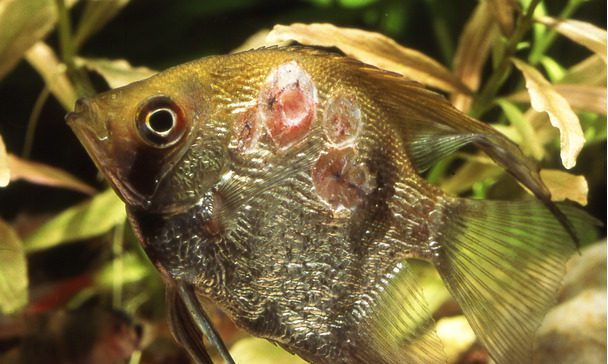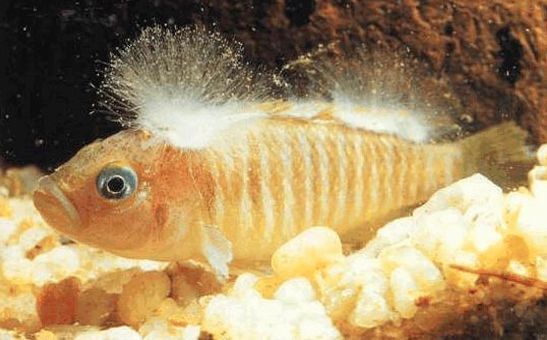
Diseases of aquarium fish

An aquarium can decorate any interior and it is very interesting to observe the unhurried life in it. To keep the aquarium clean and the inhabitants healthy, you need to make a lot of effort. However, sometimes fish can get sick. What is the cause of fish diseases?
There are many factors that affect the health of fish:
- Poor water quality. Tap water must be defended and, if necessary, special preparations must be added to bring the water to a state suitable for life for fish and other aquarium pets.
- Imbalance due to water changes or improper start of the aquarium, too early colonization of fish.
- Overfeeding. The water becomes polluted, its quality decreases, and the fish do not feel too good from overeating, many of them lack a sense of proportion.
- Overpopulation, incompatibility of inhabitants. Before you buy a fish you like, you need to find out the conditions for its maintenance, whether it gets along with other inhabitants of your aquarium. Also consider population density. There shouldn’t be too many fish.
- Failure to maintain quarantine for new fish and the introduction of sick animals. After buying a new fish, it is necessary to settle in a separate aquarium, for quarantine. This is to ensure that the fish are healthy and will not infect other inhabitants of your aquarium. The quarantine period is from 3 to 8 weeks, because it is during this period that the disease, if any, should already appear.
Major diseases and their manifestations
Pseudomonosis (fin rot)
The causative agent is the bacterium Pseudomonas. One of the most common diseases. It develops most often in heavily polluted water, as well as when kept in too cold water. A bacterial infection is manifested by erosion of the fins, the appearance of a cloudy bluish coating on them, and red dots are also often visible. At first, erosion is located at the edge of the fin, later the fin breaks up into rays, the rays fall off at the ends, the erosion line is usually clearly visible by the white-bluish color. In young fish, the fins often break down to the base, where a white ulcer forms, bones may even be exposed, and the fish dies. Salt baths, bicillin-5, chloramphenicol, streptocid are used for treatment.
Saprolegniosis
Fungal disease, causative agent – mold fungi Saprolegnia. More often it develops as a secondary infection in heavily polluted water or in fish weakened by another disease. It is manifested by the appearance of a cotton-like white or light yellow coating and thin white threads on the affected area. It can affect any part of the body, more often – gills, fins, eyes, and also eggs. The rays of the fins stick together and collapse, if the fungus is on the gills – the gill filaments become gray and die off, if in front of the eyes – the fish loses its sight, the eye turns white. A sick individual loses its appetite, becomes inactive, lies more at the bottom. Without treatment and improvement of conditions in the aquarium, most often the fish dies. Treatment – streptocid, bicillin-5 is used in a common aquarium, in a separate container – salt, copper sulfate (carefully, if the dosage is incorrect, it will harm the fish). It is easy to prevent if you keep the aquarium clean.
ascites (dropsy)
It acts more often as a symptom of many diseases, parasitic and bacterial. It is characterized by mucous excrement, and later by the destruction of the intestinal walls, the accumulation of fluid in the abdominal cavity, the abdomen swells, the scales are raised above the surface of the body and ruffled, bulging eyes may develop. The fish can hang in one position for a long time, it becomes inactive. At the stage of ruffling the scales, the treatment is ineffective, in the early stages, Baktopur, Oxytetracycline can be used, in case of mass death of fish, the aquarium is restarted with disinfection.
Exophthalmos (bulging eyes)
Often occurs with heavily polluted water, and may be a concomitant sign of other diseases. The eyes – one or both – increase in size and protrude from the orbits, the surface becomes cloudy, this happens due to the accumulation of fluid in or behind the eye. In severe cases, the fish can completely lose the eye. Treatment methods should be based on the cause of the disease and on improving the conditions in the aquarium.
Tuberculosis (mycobacteriosis)
The causative agent of fish tuberculosis is the bacterium Mycobacterium piscum The symptoms of this disease can be very different. In cichlids, signs are exhaustion, indigestion, destruction of the skin, and the formation of ulcers. In labyrinths – bulging eyes, hunchback, loss of scales, an increase in the abdominal cavity and filling it with curdled mass. In goldfish – indigestion, dropsy, bulging eyes, loss of balance. In the Characins and Pecilias, there is a curvature of the spine, tumors and ulcers, dropsy, bulging eyes. Sick fish are oppressed, swim in an inclined position with their heads up, hide in secluded places. Tuberculosis can be treated only in the early stages, more often they use kanamycin and rifampicin, feeding it to fish along with food, or isoniazid, adding to aquarium water. If the disease is too advanced, it remains to destroy the fish, and restart the aquarium with a thorough disinfection. The pathogen can be dangerous to humans, but the pathogen is not the one that causes tuberculosis in humans. This disease is also called an aquarium granuloma, it manifests itself in the form of skin irritation, scratches and abrasions do not heal for a long time, they easily become inflamed. Infection occurs rarely, more often in people with a weakened immune system and pre-existing skin diseases. If you suspect an outbreak of tuberculosis in the aquarium, it is better to work with gloves.
Hexamitosis
The disease is caused by protozoan microorganisms, the flagellates Hexamita (Octomitus) truttae, which damage the intestines and gallbladder of fish. The fish become very thin, become inactive, the anus becomes inflamed, the excrement acquires a slimy, viscous, whitish appearance. The lateral line darkens, tubercles, ulcers appear on the body and on the head, up to large holes with a white mass in them. Fins, gill covers and cartilage tissue are destroyed. The most susceptible to the disease are cichlids – astronotus, flowerhorns, scalars, as well as discus, labyrinth fish, much less often the disease affects catfish, characins and cyprinids. The treatment consists in manually treating large ulcers with spirohexol or flagellol, raising the temperature to 33-35 degrees Celsius, but consider the characteristics of the fish – not everyone can withstand such a temperature. Also, treatment is with erythrocycline (40-50 mg/l) with the addition of griseofulvin or metronidazole (10 mg/l) for 10-12 days. After treatment, the ulcers heal, leaving scars and scars.
Lepidortosis
An infectious disease, the causative agent of the bacteria Aeromonas punctata and Pseudomonas fluorescens, in which small bubbles with liquid form under the scales of the fish, while the scales rise and ruffle. Over time, the ruffling spreads to the whole body, the scales fall out and the fish dies. Treatment is effective only in the early stages. Bicillin-5, biomycin, streptocide are used in the form of baths in a common aquarium. If the disease is too advanced, the population of the aquarium is destroyed, the aquarium is restarted with thorough disinfection.
Branchiomycosis
Fungal disease, pathogens – fungi Branchiomyces sanguinis and B.demigrans, affects the gills. Gray stripes and spots appear on the gills, then the gill filaments die off, and the gill covers are deformed. The fish are inactive, lie in the corners of the aquarium, practically do not react to external stimuli. The disease progresses very quickly, up to 3% of fish die in 7-70 days. Treatment is carried out in a separate container, with copper sulfate (carefully), rivanol. The aquarium is thoroughly cleaned.
Arguloz
Small translucent crustaceans of the genus Argulus, which are also called “carpoed” and “fish louse”, parasitize on fish, attaching to the skin and fins, and sucking blood. At the site of attachment, hemorrhages and non-healing ulcers form, which can become infected with bacteria and fungi, the fish become lethargic and lethargic. Treatment includes jigging, baths with solutions of potassium permanganate, chlorophos and cyprinopur, and mechanical removal of crustaceans with tweezers, which can be easily done due to the relatively large – up to 0,6 cm – size of the crustacean.
Ichthyophthiriosis (manka)
Fish become infected with ciliates Ichthyophthirius multifiliis. Small white grains become noticeable on the body, the so-called dermoid tubercles, similar to semolina, for which the name “semolina” is attached to the disease. There are symptoms such as weakness, itching, decreased activity. You can treat it by reducing the aeration of the aquarium and adding salt to the water, also use malachite green, Kostapur.
Oodinia (velvet disease, velvet disease, gold dust)
The disease is also caused by the protozoan Piscnoodinium pillulare. The main symptom is very small grains on the body, similar to golden dust or fine sand. Fish behave “squeezed”, hide, gather at the surface or at the bottom. The fins stick together, and later split, leaving only the bare rays of the fins. The gills are destroyed, the skin peels off, and the fish dies. Carp and labyrinth fish are especially susceptible to the disease. Treatment – bicillin 5, copper sulfate.
Ichthyobodosis
Parasite – flagellate Costia (Ichthyobodo) necatrix infects the mucous membrane of fish. Cloudy pale spots of a bluish coating are visible on the body. The fins stick together, the movements of the fish become unnatural and constrained. The gills swell and become covered with a layer of mucus, the gill covers protrude to the sides. The fish stay close to the surface, panting. Treatment – baths with malachite green, salt baths, potassium permanganate. Methylene blue helps prevent saprolegniosis from developing on affected fish.
Gyrodactylosis
Gyrodactylus worms damage the body and fins. The body is covered with a layer of mucus, light spots, erosions, and hemorrhages are visible on the fish. The fins are frayed and destroyed. The fish swim stiffly, startle. Treatment consists of introducing praziquantel preparations into the aquarium, as well as using short-term salt baths.
Glugeosis
Sporadic disease, causative agent – sporozoan Glugea. Red spots, tumors, ulcers appear on the fish, bulging eyes develop. Cysts in the connective tissue form pineal outgrowths, the formation of cysts in the body cavities and on the internal organs leads to the death of the fish. There is no cure, it is advisable to destroy all the inhabitants of the aquarium, boil the scenery, thoroughly disinfect the aquarium. Very often, diseases develop with poor aquarium care, insufficient filtration and cleaning frequency, unsuitable water conditions and parameters, feeding untested live food, and lack of quarantine for new pets. It is very important to follow the rules for the care of the aquarium.





